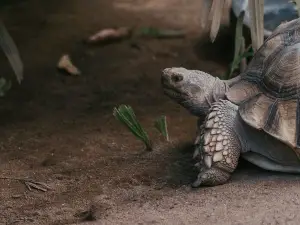
Any sort of injury on any of your pets will understandably worry you, your tortoise included.
Here is what you need to know if your tortoise has a cut on its leg.
Table of Contents
Tortoise cut on leg:
Injuries can be small and minor or they can be very large and severe and you’d need to at least keep an eye on your pet in both cases.
This is what you need to know if your tortoise has a cut on its leg:
Tortoise cut on leg:
The skin on your tortoise’s legs isn’t covered by the shell and will thus be more susceptible to damage, including damage like a cut to the leg.
These animals can develop cuts on their legs for a variety of reasons like if they are attacked, cut themselves on fences, or if they repeatedly put their foot through mesh, this can cause a wound over time.
What to do:
If your pet simply scraped its leg, and the leg is not bleeding, then keep an eye on the turtle’s leg to make sure that it heals properly on its own
If your pet’s leg is bleeding then you can stop it using some pressure and a clean piece of cotton wool.
Stop the bleeding by dampening the piece of cotton wool with some clean water and pressing it onto the cut. This will get the wound to clot and close up.
If you so desire to you can also get your pet to the vet for a check-up.
Courtship injuries:
The males of the tortoise species aren’t always welcomed by the females when they want to mate.
A female tortoise may try to get away from the male suitor but the male will bite at her legs to slow her down and stop her.
These animals may seem quite harmless, especially because they don’t have teeth, but the male tortoise can be quite aggressive and may bite with his sharp jaw and cut the female tortoise’s legs.
What to do:
These bites aren’t usually deep enough that they may injure the female and cause her to bleed but they sometimes can be.
If she is not bleeding, and the male hasn’t cut through her leg, then she will be fine and you can let them be.
If she is bleeding then isolate the male tortoise, stop the female tortoise’s bleeding, and give her some time and space to heal
Warning:
If you don’t stop the bleeding and the tortoise’s wound doesn’t close up then this can attract flies which can lay eggs that produce maggots.
If this happens then you’d need to irrigate the wound about 2-3 times a day using a betadine/iodine solution.
Dilute some betadine/iodine in some warm water until the mixture is the color of ice tea and then flush out the animal’s wound.
Chlorhexidine can also be used to clean out your pet’s wound.
Keep your pet indoors to keep flies from getting to the wound and laying eggs
Limit your pet’s activity so the wound can heal and keep an eye out for signs of an infection.
If your pet’s wound starts to swell up and if there is any redness then you’d need to take your pet to the vet.
If you enjoyed this article then you may also be interested in other turtle/tortoise related articles. Here are some articles that you may be interested in: Tortoise Bleeding Leg, Baby Tortoise Leg Problems, Tortoise Having Trouble Walking At Night, Turtle Bulging Out Of Shell, Red Spots On Turtle Belly, Algae Growing On Turtle Head, Adding Salt To A Turtle Tank, Wheat Germ Pellets For Turtles, How To Fix Retained Scutes

